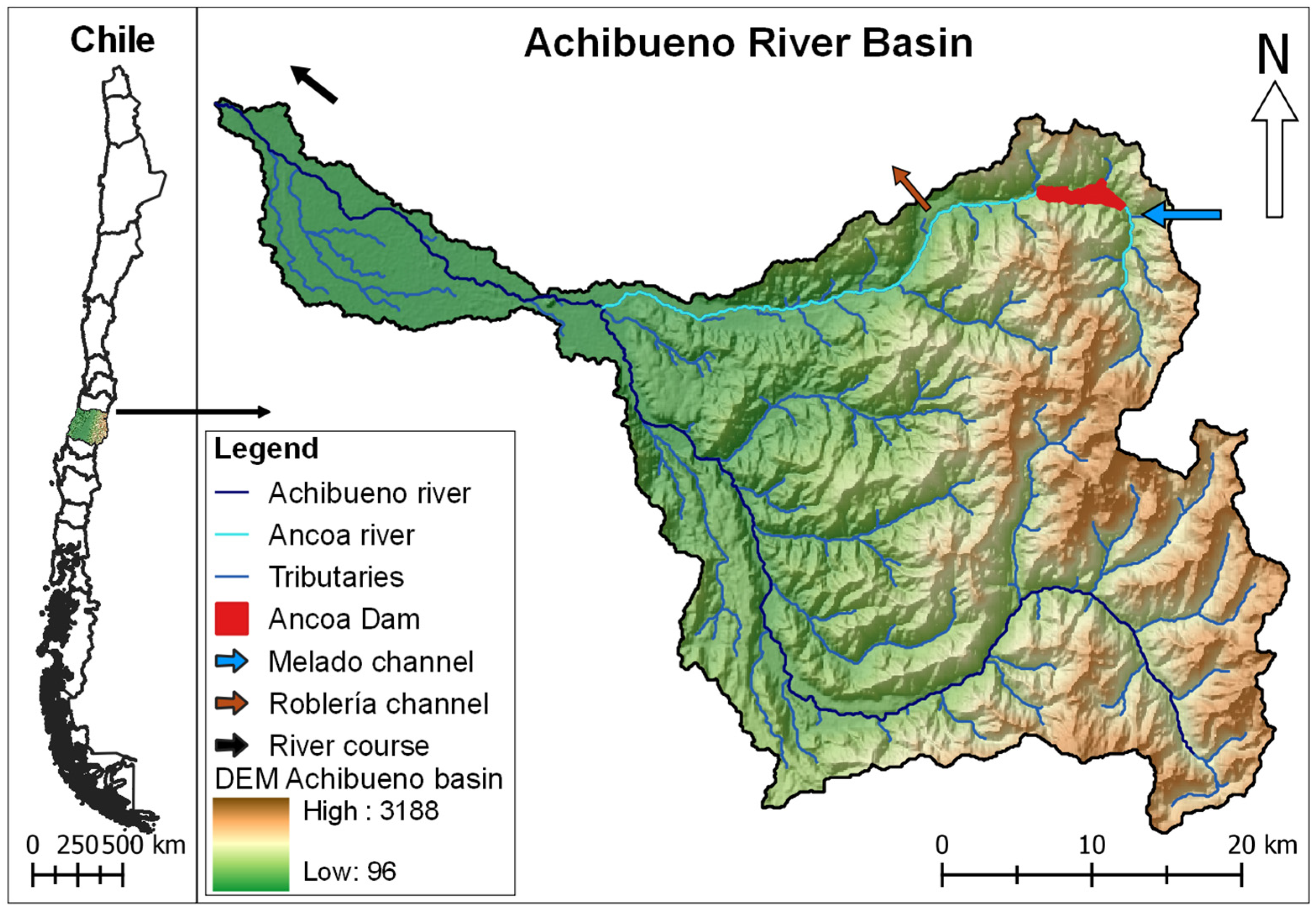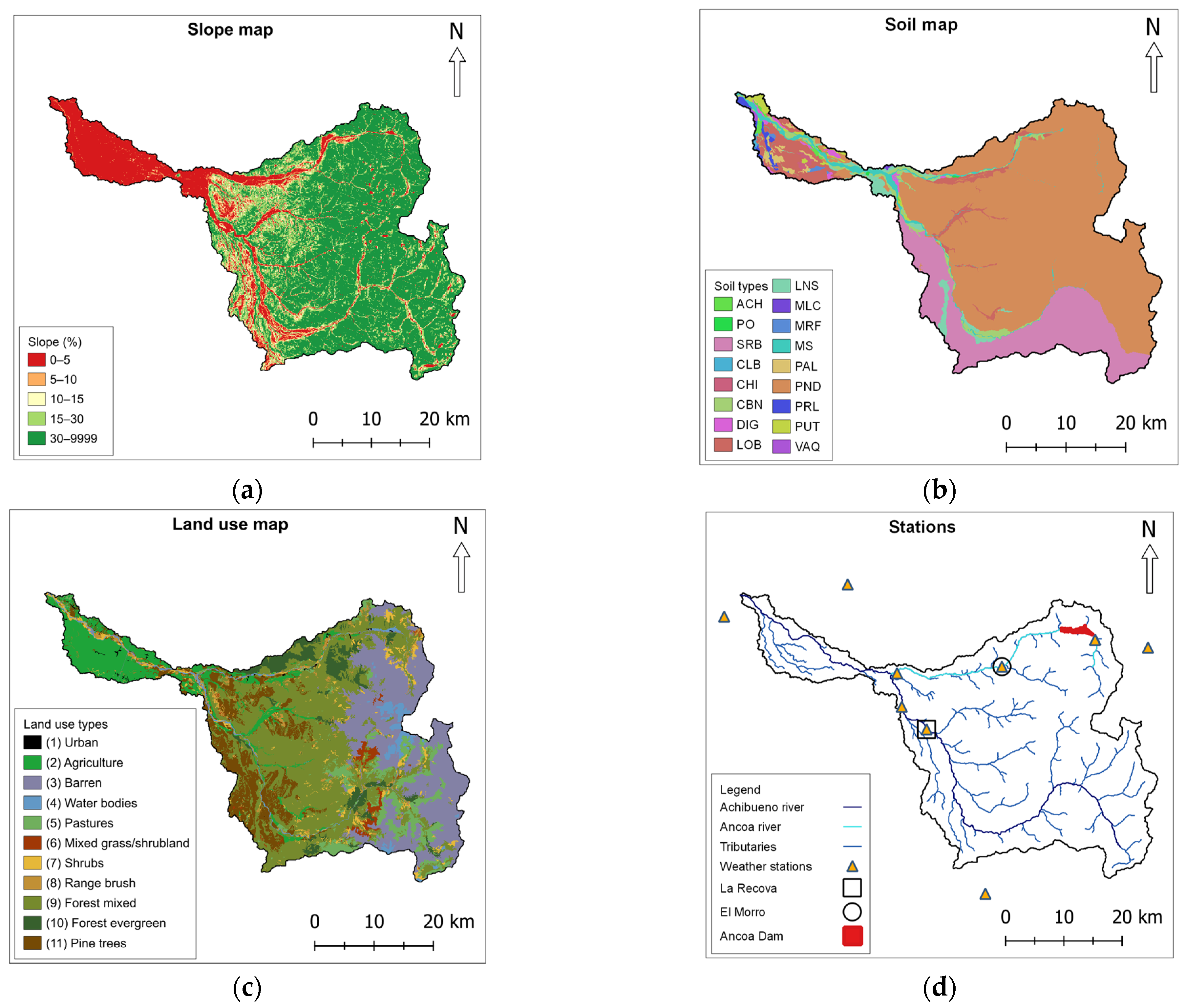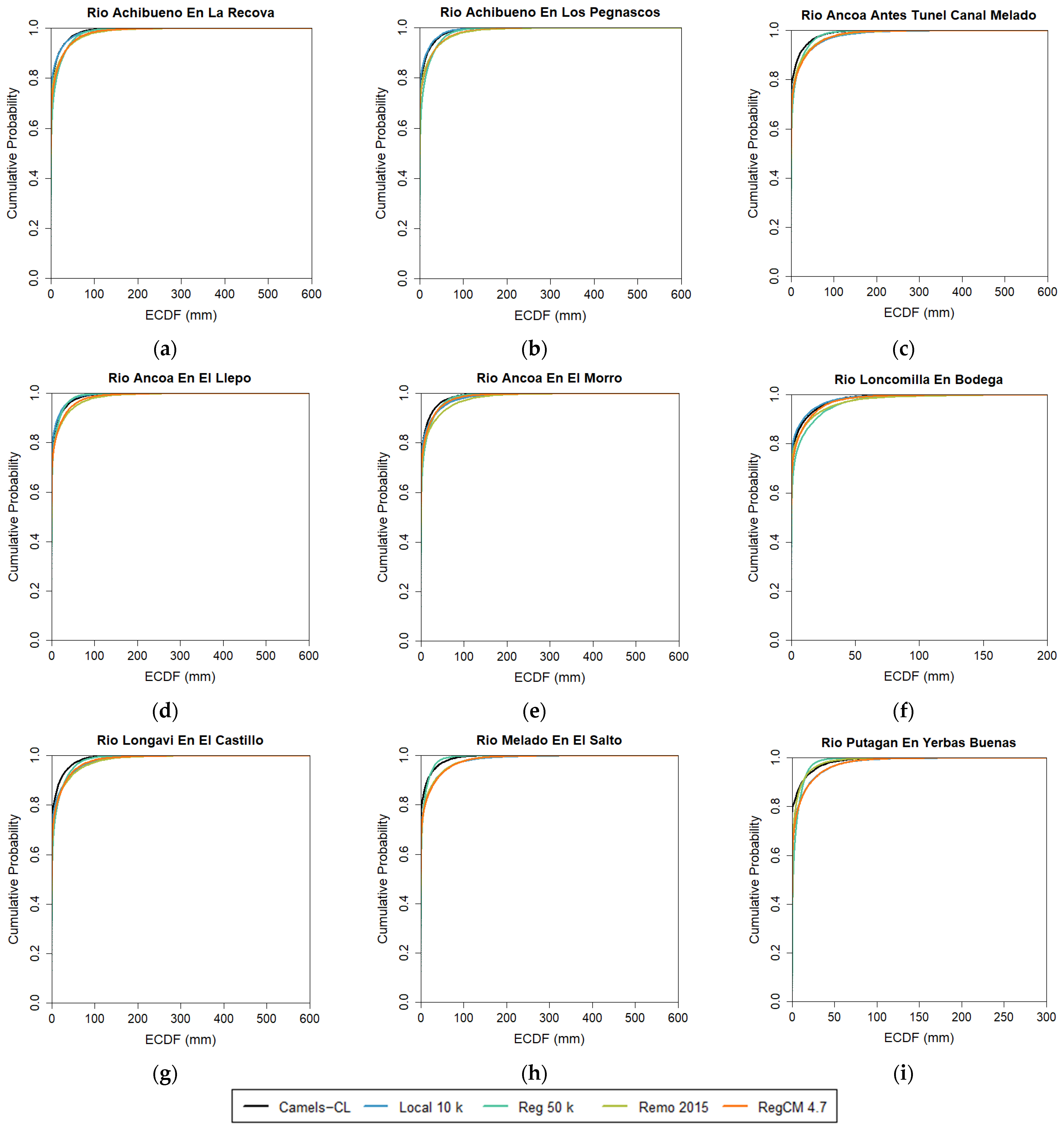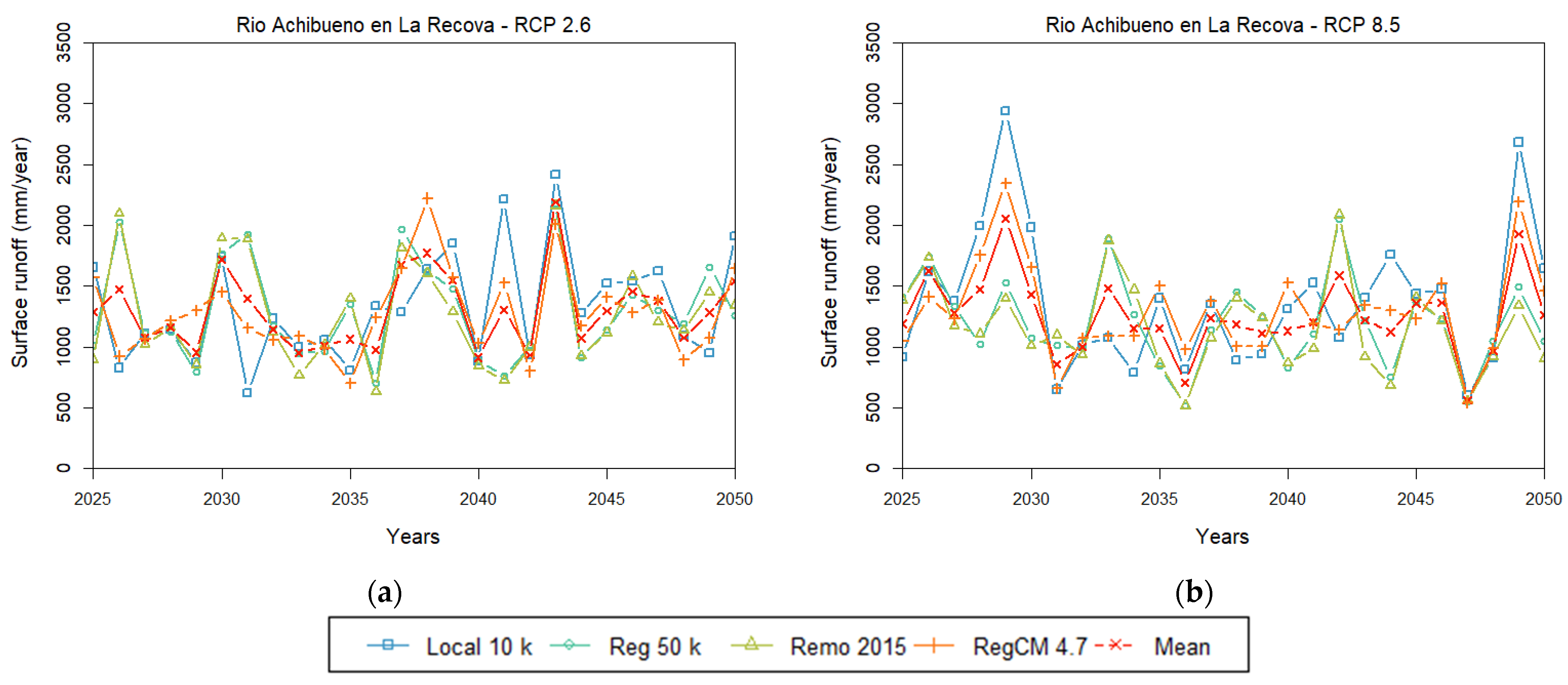Impact of Future Climate Scenarios and Bias Correction Methods on the Achibueno River Basin
Abstract
1. Introduction
2. Materials and Methods
2.1. Study Area
2.2. SWAT+ Model Setup
2.2.1. Input Parameters in SWAT+
2.2.2. Sensitivity Analysis, Calibration, and Validation of the Model
2.3. Climate Model Evaluation
2.3.1. Selected Climate Models
2.3.2. Bias Correction Methods
2.3.3. Evaluation of Bias Correction
2.3.4. Climate Scenarios
3. Results
3.1. Swat+ Simulation, Calibration, and Validation
3.2. Climate Models
3.3. Bias Correction Methods
3.4. Future Climate Scenarios
4. Conclusions
Author Contributions
Funding
Data Availability Statement
Acknowledgments
Conflicts of Interest
References
- Painter, J.; Ettinger, J.; Doutreix, M.-N.; Strauß, N.; Wonneberger, A.; Walton, P. Is it climate change? Coverage by online news sites of the 2019 European summer heatwaves in France, Germany, the Netherlands, and the UK. Clim. Chang. 2021, 169, 4. [Google Scholar] [CrossRef]
- Nissen, K.M.; Ulbrich, U. Increasing frequencies and changing characteristics of heavy precipitation events threatening infrastructure in Europe under climate change. Nat. Hazards Earth Syst. Sci. 2017, 17, 1177–1190. [Google Scholar] [CrossRef]
- Lv, X.; Zuo, Z.; Ni, Y.; Sun, J.; Wang, H. The effects of climate and catchment characteristic change on streamflow in a typical tributary of the Yellow River. Sci. Rep. 2019, 9, 14535. [Google Scholar] [CrossRef] [PubMed]
- Moraga, J.S.; Peleg, N.; Fatichi, S.; Molnar, P.; Burlando, P. Revealing the impacts of climate change on mountainous catchments through high-resolution modelling. J. Hydrol. 2021, 603, 126806. [Google Scholar] [CrossRef]
- Muñoz, A.A.; Klock-Barría, K.; Alvarez-Garreton, C.; Aguilera-Betti, I.; González-Reyes, Á.; Lastra, J.A.; Chávez, R.O.; Barría, P.; Christie, D.; Rojas-Badilla, M.; et al. Water Crisis in Petorca Basin, Chile: The Combined Effects of a Mega-Drought and Water Management. Water 2020, 12, 648. [Google Scholar] [CrossRef]
- Neupane, D.; Adhikari, P.; Bhattarai, D.; Rana, B.; Ahmed, Z.; Sharma, U.; Adhikari, D. Does Climate Change Affect the Yield of the Top Three Cereals and Food Security in the World? Earth 2022, 3, 45–71. [Google Scholar] [CrossRef]
- Schmidhuber, J.; Tubiello, F.N. Global food security under climate change. Proc. Natl. Acad. Sci. USA 2007, 104, 19703–19708. [Google Scholar] [CrossRef] [PubMed]
- Teutschbein, C.; Seibert, J. Regional Climate Models for Hydrological Impact Studies at the Catchment Scale: A Review of Recent Modeling Strategies. Geogr. Compass 2010, 4, 834–860. [Google Scholar] [CrossRef]
- Cardell, M.F.; Romero, R.; Amengual, A.; Homar, V.; Ramis, C. A quantile–quantile adjustment of the EURO-CORDEX projections for temperatures and precipitation. Int. J. Climatol. 2019, 39, 2901–2918. [Google Scholar] [CrossRef]
- Chen, J.; Arsenault, R.; Brissette, F.P.; Zhang, S.B. Climate Change Impact Studies: Should We Bias Correct Climate Model Outputs or Post-Process Impact Model Outputs? Water Resour. Res. 2021, 57, e2020WR028638. [Google Scholar] [CrossRef]
- Gumindoga, W.; Rientjes, T.H.M.; Tamiru Haile, A.; Makurira, H.; Reggiani, P. Performance of bias-correction schemes for CMORPH rainfall estimates in the Zambezi River basin. Hydrol. Earth Syst. Sci. 2019, 23, 2915–2938. [Google Scholar] [CrossRef]
- Holthuijzen, M.; Beckage, B.; Clemins, P.J.; Higdon, D.; Winter, J.M. Robust bias-correction of precipitation extremes using a novel hybrid empirical quantile-mapping method: Advantages of a linear correction for extremes. Theor. Appl. Climatol. 2022, 149, 863–882. [Google Scholar] [CrossRef]
- Maraun, D. Bias Correcting Climate Change Simulations—A Critical Review. Curr. Clim. Chang. Rep. 2016, 2, 211–220. [Google Scholar] [CrossRef]
- Ngai, S.T.; Tangang, F.; Juneng, L. Bias correction of global and regional simulated daily precipitation and surface mean temperature over Southeast Asia using quantile mapping method. Glob. Planet. Chang. 2017, 149, 79–90. [Google Scholar] [CrossRef]
- Gudmundsson, L.; Bremnes, J.B.; Haugen, J.E.; Engen-Skaugen, T. Technical Note: Downscaling RCM precipitation to the station scale using statistical transformations; a comparison of methods. Hydrol. Earth Syst. Sci. 2012, 16, 3383–3390. [Google Scholar] [CrossRef]
- Ayugi, B.; Tan, G.; Ruoyun, N.; Babaousmail, H.; Ojara, M.; Wido, H.; Mumo, L.; Ngoma, N.H.; Nooni, I.K.; Ongoma, V. Quantile Mapping Bias Correction on Rossby Centre Regional Climate Models for Precipitation Analysis over Kenya, East Africa. Water 2020, 12, 801. [Google Scholar] [CrossRef]
- Enayati, M.; Bozorg-Haddad, O.; Bazrafshan, J.; Hejabi, S.; Chu, X.F. Bias correction capabilities of quantile mapping methods for rainfall and temperature variables. J. Water Clim. Chang. 2021, 12, 401–419. [Google Scholar] [CrossRef]
- Soriano, E.; Mediero, L.; Garijo, C. Selection of Bias Correction Methods to Assess the Impact of Climate Change on Flood Frequency Curves. Water 2019, 11, 2266. [Google Scholar] [CrossRef]
- Sundaram, G.; Radhakrishnan, S. Performance Evaluation of Bias Correction Methods and Projection of Future Precipitation Changes Using Regional Climate Model over Thanjavur, Tamil Nadu, India. Ksce J. Civ. Eng. 2023, 27, 878–889. [Google Scholar] [CrossRef]
- Breuer, L.; Huisman, J.A.; Willems, P.; Bormann, H.; Bronstert, A.; Croke, B.F.W.; Frede, H.G.; Graff, T.; Hubrechts, L.; Jakeman, A.J.; et al. Assessing the impact of land use change on hydrology by ensemble modeling (LUCHEM). I: Model intercomparison with current land use. Adv. Water Resour. 2009, 32, 129–146. [Google Scholar] [CrossRef]
- Dwarakish, G.S.; Ganasri, B.P.; De Stefano, L. Impact of land use change on hydrological systems: A review of current modeling approaches. Cogent Geosci. 2015, 1, 1115691. [Google Scholar] [CrossRef]
- Klöcking, B.; Ströbl, B.; Knoblauch, S.; Maier, U.; Pfützner, B.; Gericke, A. Development and allocation of land-use scenarios in agriculture for hydrological impact studies. Phys. Chem. Earth Parts A/B/C 2003, 28, 1311–1321. [Google Scholar] [CrossRef]
- Lahmer, W.; Pfutzner, B.; Becker, A. Assessment of land use and climate change impacts on the mesoscale. Phys. Chem. Earth Part B-Hydrol. Ocean. Atmos. 2001, 26, 565–575. [Google Scholar] [CrossRef]
- Arnold, J.G.; Srinivasan, R.; Muttiah, R.S.; Williams, J.R. Large Area Hydrologic Modeling and Assessment Part I: Model Development1. JAWRA J. Am. Water Resour. Assoc. 2007, 34, 73–89. [Google Scholar] [CrossRef]
- Bieger, K.; Arnold, J.G.; Rathjens, H.; White, M.J.; Bosch, D.D.; Allen, P.M. Representing the Connectivity of Upland Areas to Floodplains and Streams in SWAT. J. Am. Water Resour. Assoc. 2019, 55, 578–590. [Google Scholar] [CrossRef]
- Bieger, K.; Arnold, J.G.; Rathjens, H.; White, M.J.; Bosch, D.D.; Allen, P.M.; Volk, M.; Srinivasan, R. Introduction to SWAT plus, A Completely Restructured Version of the Soil and Water Assessment Tool. J. Am. Water Resour. Assoc. 2017, 53, 115–130. [Google Scholar] [CrossRef]
- Musie, M.; Sen, S.; Chaubey, I. Hydrologic Responses to Climate Variability and Human Activities in Lake Ziway Basin, Ethiopia. Water 2020, 12, 164. [Google Scholar] [CrossRef]
- Nasiri, S.; Ansari, H.; Ziaei, A.N. Simulation of water balance equation components using SWAT model in Samalqan Watershed (Iran). Arab. J. Geosci. 2020, 13, 421. [Google Scholar] [CrossRef]
- Nkwasa, A.; Chawanda, C.J.; Msigwa, A.; Komakech, H.C.; Verbeiren, B.; van Griensven, A. How Can We Represent Seasonal Land Use Dynamics in SWAT and SWAT plus Models for African Cultivated Catchments? Water 2020, 12, 1541. [Google Scholar] [CrossRef]
- Araya-Osses, D.; Casanueva, A.; Román-Figueroa, C.; Uribe, J.M.; Paneque, M. Climate change projections of temperature and precipitation in Chile based on statistical downscaling. Clim. Dyn. 2020, 54, 4309–4330. [Google Scholar] [CrossRef]
- Blin, N.; Hausner, M.; Leray, S.; Lowry, C.; Suarez, F. Potential impacts of climate change on an aquifer in the arid Altiplano, northern Chile: The case of the protected wetlands of the Salar del Huasco basin. J. Hydrol.-Reg. Stud. 2022, 39, 100996. [Google Scholar] [CrossRef]
- Martínez-Retureta, R.; Aguayo, M.; Stehr, A.; Sauvage, S.; Echeverría, C.; Sánchez-Pérez, J.-M. Effect of Land Use/Cover Change on the Hydrological Response of a Southern Center Basin of Chile. Water 2020, 12, 302. [Google Scholar] [CrossRef]
- Omani, N.; Srinivasan, R.; Karthikeyan, R.; Reddy, K.V.; Smith, P.K. Impacts of Climate Change on the Glacier Melt Runoff from Five River Basins. Trans. Asabe 2016, 59, 829–848. [Google Scholar] [CrossRef]
- Omani, N.; Srinivasan, R.; Karthikeyan, R.; Smith, P.K. Hydrological Modeling of Highly Glacierized Basins (Andes, Alps, and Central Asia). Water 2017, 9, 111. [Google Scholar] [CrossRef]
- Stehr, A.; Debels, P.; Arumi, J.L.; Romero, F.; Alcayaga, H. Combining the Soil and Water Assessment Tool (SWAT) and MODIS imagery to estimate monthly flows in a data-scarce Chilean Andean basin. Hydrol. Sci. J.-J. Des Sci. Hydrol. 2009, 54, 1053–1067. [Google Scholar] [CrossRef]
- Stehr, A.; Debels, P.; Romero, F.; Alcayaga, H. Hydrological modelling with SWAT under conditions of limited data availability: Evaluation of results from a Chilean case study. Hydrol. Sci. J.-J. Des Sci. Hydrol. 2008, 53, 588–601. [Google Scholar] [CrossRef]
- Martínez Martínez, Y.; Goecke Coll, D.; Aguayo, M.; Casas-Ledón, Y. Effects of landcover changes on net primary production (NPP)-based exergy in south-central of Chile. Appl. Geogr. 2019, 113, 102101. [Google Scholar] [CrossRef]
- Moya, H.; Althoff, I.; Huenchuleo, C.; Reggiani, P. Influence of Land Use Changes on the Longaví Catchment Hydrology in South-Center Chile. Hydrology 2022, 9, 169. [Google Scholar] [CrossRef]
- Stehr, A.; Aguayo, M.; Link, O.; Parra, O.; Romero, F.; Alcayaga, H. Modelling the hydrologic response of a mesoscale Andean watershed to changes in land use patterns for environmental planning. Hydrol. Earth Syst. Sci. 2010, 14, 1963–1977. [Google Scholar] [CrossRef]
- Uniyal, B.; Dietrich, J.; Vu, N.Q.; Jha, M.K.; Arumi, J.L. Simulation of regional irrigation requirement with SWAT in different agro-climatic zones driven by observed climate and two reanalysis datasets. Sci. Total Environ. 2019, 649, 846–865. [Google Scholar] [CrossRef]
- SERNAGEOMIN. Mapa Geológico de Chile: Versión digital; Publicación Geológica Digital, No. 4. 2003. Available online: http://www.ipgp.fr/~dechabal/Geol-millon.pdf (accessed on 12 February 2024).
- Alvarez-Garreton, C.; Mendoza, P.A.; Boisier, J.P.; Addor, N.; Galleguillos, M.; Zambrano-Bigiarini, M.; Lara, A.; Puelma, C.; Cortes, G.; Garreaud, R.; et al. The CAMELS-CL dataset: Catchment attributes and meteorology for large sample studies—Chile dataset. Hydrol. Earth Syst. Sci. 2018, 22, 5817–5846. [Google Scholar] [CrossRef]
- Dile, Y.; Srinivasan, R.; George, C. QGIS Interface for SWAT+: QSWAT+. 2022 (v 2.0). Available online: http://docplayer.net/204909159-Qgis-interface-for-swat-qswat.html (accessed on 12 February 2024).
- Jarvis, A.; Reuter, H.I.; Nelson, A.; Guevara, E. Hole-Filled Seamless SRTM Data V4, International Centre for Tropical Agriculture (CIAT). CIAT. 2008. Available online: http://srtm.csi.cgiar.org (accessed on 12 February 2024).
- CIREN. Estudio Agrológico VII Región. Descripción de Suelos, Materiales y Símbolos; Centro de Información de Recursos Naturales: Santiago, Chile, 1997; pp. 1–660. [Google Scholar]
- CONAF. Catastro de Uso del Suelo y Vegetación. Monitoreo y Actualización en la VII Región del Maule. Corporacion Nacional Forestal. 2016. Available online: http://sit.conaf.cl (accessed on 12 February 2024).
- Molina, A.; Falvey, M.; Rondanelli, R. A solar radiation database for Chile. Sci. Rep. 2017, 7, 14823. [Google Scholar] [CrossRef] [PubMed]
- Abbaspour, K.; Vaghefi, S.; Srinivasan, R. A Guideline for Successful Calibration and Uncertainty Analysis for Soil and Water Assessment: A Review of Papers from the 2016 International SWAT Conference. Water 2017, 10, 6. [Google Scholar] [CrossRef]
- Yen, H.; Park, S.; Arnold, J.G.; Srinivasan, R.; Chawanda, C.J.; Wang, R.Y.; Feng, Q.Y.; Wu, J.W.; Miao, C.Y.; Bieger, K.; et al. IPEAT plus: A Built-In Optimization and Automatic Calibration Tool of SWAT. Water 2019, 11, 1681. [Google Scholar] [CrossRef]
- Knoben, W.J.M.; Freer, J.E.; Woods, R.A. Technical note: Inherent benchmark or not? Comparing Nash--Sutcliffe and Kling--Gupta efficiency scores. Hydrol. Earth Syst. Sci. 2019, 23, 4323–4331. [Google Scholar] [CrossRef]
- Krause, P.; Boyle, D.P.; Bäse, F. Comparison of different efficiency criteria for hydrological model assessment. Adv. Geosci. 2005, 5, 89–97. [Google Scholar] [CrossRef]
- Moriasi, D.N.; Gitau, M.W.; Pai, N.; Daggupati, P. Hydrologic and Water Quality Models: Performance Measures and Evaluation Criteria. Trans. Asabe 2015, 58, 1763–1785. [Google Scholar] [CrossRef]
- Pool, S.; Vis, M.; Seibert, J. Evaluating model performance: Towards a non-parametric variant of the Kling-Gupta efficiency. Hydrol. Sci. J.-J. Des Sci. Hydrol. 2018, 63, 1941–1953. [Google Scholar] [CrossRef]
- Centro de Ciencia del Clima y la Resiliencia (CR)2. Simulaciones Climáticas Regionales. 2018. Available online: https://www.cr2.cl/wp-content/uploads/2020/05/Guia_para-la-Plataforma-de-visualizacion-de-simulaciones-clima%CC%81ticas.pdf (accessed on 12 February 2024).
- Ines, A.V.M.; Hansen, J.W. Bias correction of daily GCM rainfall for crop simulation studies. Agr. For. Meteorol. 2006, 138, 44–53. [Google Scholar] [CrossRef]
- Geleta, C.D.; Gobosho, L. Climate Change Induced Temperature Prediction and Bias Correction in Finchaa Watershed. Am.-Eurasian J. Agric. Environ. Sci. 2018, 18, 324–337. [Google Scholar]
- Falco, M.; Carril, A.F.; Menéndez, C.G.; Zaninelli, P.G.; Li, L.Z.X. Assessment of CORDEX simulations over South America: Added value on seasonal climatology and resolution considerations. Clim. Dyn. 2018, 52, 4771–4786. [Google Scholar] [CrossRef]
- Torrez-Rodriguez, L.; Goubanova, K.; Muñoz, C.; Montecinos, A. Evaluation of temperature and precipitation from CORDEX-CORE South America and Eta-RCM regional climate simulations over the complex terrain of Subtropical Chile. Clim. Dyn. 2023, 61, 3195–3221. [Google Scholar] [CrossRef]
- Solman, S.A.; Blázquez, J. Multiscale precipitation variability over South America: Analysis of the added value of CORDEX RCM simulations. Clim. Dyn. 2019, 53, 1547–1565. [Google Scholar] [CrossRef]
- López-Franca, N.; Zaninelli, P.G.; Carril, A.F.; Menéndez, C.G.; Sánchez, E. Changes in temperature extremes for 21st century scenarios over South America derived from a multi-model ensemble of regional climate models. Clim. Res. 2016, 68, 151–167. [Google Scholar] [CrossRef]
- Boé, J.; Terray, L.; Habets, F.; Martin, E. Statistical and dynamical downscaling of the Seine basin climate for hydro-meteorological studies. Int. J. Climatol. 2007, 27, 1643–1655. [Google Scholar] [CrossRef]
- Tong, Y.; Gao, X.; Han, Z.; Xu, Y.; Xu, Y.; Giorgi, F. Bias correction of temperature and precipitation over China for RCM simulations using the QM and QDM methods. Clim. Dyn. 2020, 57, 1425–1443. [Google Scholar] [CrossRef]
- Villani, V.; Rianna, G.; Mercogliano, P.; Zollo, A.L.; Schiano, P. Statistical Approaches Versus Weather Generator to Downscale Rcm Outputs to Point Scale: A Comparison of Performances. J. Urban Environ. Eng. 2015, 8, 142–154. [Google Scholar] [CrossRef]
- Aitken, D.; Rivera, D.; Godoy-Faúndez, A.; Holzapfel, E. Water Scarcity and the Impact of the Mining and Agricultural Sectors in Chile. Sustainability 2016, 8, 128. [Google Scholar] [CrossRef]
- Lagos-Zúñiga, M.; Balmaceda-Huarte, R.; Regoto, P.; Torrez, L.; Olmo, M.; Lyra, A.; Pareja-Quispe, D.; Bettolli, M.L. Extreme indices of temperature and precipitation in South America: Trends and intercomparison of regional climate models. Clim. Dyn. 2022, 1–22. [Google Scholar] [CrossRef]
- González-Zeas, D.; Garrote, L.; Iglesias, A.; Sordo-Ward, A. Improving runoff estimates from regional climate models: A performance analysis in Spain. Hydrol. Earth Syst. Sci. 2012, 16, 1709–1723. [Google Scholar] [CrossRef]
- Christensen, J.H.; Boberg, F.; Christensen, O.B.; Lucas-Picher, P. On the need for bias correction of regional climate change projections of temperature and precipitation. Geophys. Res. Lett. 2008, 35, L20709. [Google Scholar] [CrossRef]








| Type | Input Data | Description | Source |
|---|---|---|---|
| Spatial Data | DEM | Digital elevation model (90 m resolution) | Shuttle Radar Topography Mission [44] |
| Soil type | Soil samples and agrological study of El Maule | Field studies and CIREN 1997 [45] | |
| Land use | Land use map from 2016 | CONAF 2017 [46] | |
| Meteorological Data | Temperature | Minimum and maximum temperature (9 *) | Camels-CL dataset [42] |
| Precipitations | Daily precipitations (9 *) | Camels-CL dataset [42] | |
| Wind velocity | Daily wind (4 *) | DGA | |
| Relative humidity | Daily relative humidity (1 *) | DGA |
| Symbol | Name | Layers | Depth (cm) * | BD (g cm−3) * | CBN (%) * | K (mm h−1) * | pH * | Texture * |
|---|---|---|---|---|---|---|---|---|
| ACH | Achibueno | 3 | 1200 | 1.6 | 1.3 | 11.8 | 6.3 | Loam |
| PO | Asociación Posillas | 3 | 1150 | 1.3 | 0.8 | 14.6 | 6.2 | Clay loam |
| SRB | Asociación Sierra Bellavista | 3 | 800 | 1.5 | 1.2 | 64.2 | 6.5 | Loam sand |
| CLB | Caliboro | 4 | 1000 | 1.7 | 0.5 | 19.6 | 7.2 | Loamy |
| CHI | Chiguay | 3 | 450 | 1.6 | 1.3 | 16.3 | 5.8 | Clay loam |
| CBN | Colbun | 5 | 850 | 1.5 | 1.1 | 9.9 | 5.9 | Silty clay |
| DIG | Diguillin | 4 | 1100 | 1.1 | 4.2 | 42.6 | 6.4 | Loamy silt |
| LOB | La Obra | 3 | 800 | 1.8 | 0.9 | 13.0 | 6.0 | Loamy sand |
| LNS | Linares | 3 | 500 | 1.5 | 1.7 | 17.1 | 6.8 | Loamy sand |
| MLC | Maulecura | 2 | 550 | 1.7 | 5.5 | 29.2 | 6.6 | Loamy |
| MRF | Miraflores | 3 | 750 | 1.7 | 0.5 | 22.8 | 7.3 | Loamy |
| MS | Miscelaneo suelo | 2 | 600 | 1.3 | 1.4 | 29.2 | 5.8 | Loamy |
| PAL | Palmilla | 3 | 950 | 1.9 | 0.7 | 22.8 | 6.7 | Clay loam |
| PND | Panimavida | 3 | 900 | 1.2 | 1.0 | 22.8 | 6.2 | Clay loam |
| PRL | Parral | 4 | 1120 | 1.6 | 0.5 | 19.6 | 6.2 | Clay loam |
| PUT | Putagan | 3 | 850 | 1.5 | 1.2 | 12.1 | 6.7 | Loamy sand |
| VAQ | Vaquería | 2 | 500 | 1.7 | 0.8 | 8.2 | 5.5 | Sandy clay loam |
| Statisticians | Without Calibration | Calibration | Validation |
|---|---|---|---|
| NSE | −0.35 | 0.58 | 0.65 |
| R2 | 0.44 | 0.69 | 0.67 |
| RSR | 1.15 | 0.65 | 0.59 |
| PBIAS | 4.90 | 1.20 | −14.50 |
| KGE | 0.36 | 0.77 | 0.74 |
| Source | Precipitations | Minimum Temperatures | Maximum Temperatures | |||
|---|---|---|---|---|---|---|
| Min | Max | Min | Max | Min | Max | |
| Camels-CL | 0 | 203.1 c | −14.1 h | 15.8 i | −5.7 h | 34.1 i |
| Local 10 k | 0 | 458.6 h | −21.1 i | 22.3 f | −11.7 i | 40.3 a |
| Reg 50 k | 0 | 409.2 c | −22.6 i | 18.4 d,f | −11.4 i | 37.8 d,f |
| Remo 2015 | 0 | 412.6 e | −44.1 i | 24.4 f | −11.6 i | 41.9 a |
| RegCM 4.7 | 0 | 548.3 c,h | −26.8 i | 23.2 f | −13.2 i | 44.2 f |
| Climate Model- Bias Correction Method | Precipitation | Tmin | Tmax | ||||||
|---|---|---|---|---|---|---|---|---|---|
| MBE | MAE | RMSE | MBE | MAE | RMSE | MBE | MAE | RMSE | |
| Local 10 k | −2.2 | 10.5 | 25.5 | −2.1 | 4.7 | 5.5 | −0.1 | 6.2 | 7.3 |
| Local 10 k—PTF | 0.0 | 8.6 | 20.2 | −0.2 | 2.8 | 3.6 | 0.3 | 4.3 | 5.4 |
| Local 10 k—DIST | −1.1 | 9.6 | 23.5 | - | - | - | - | - | - |
| Local 10 k—QUANT | 0.0 | 8.7 | 20.4 | −0.5 | 2.7 | 3.4 | 0.0 | 4.0 | 5.0 |
| Local 10 k—RQUANT | 0.0 | 8.7 | 20.4 | −0.5 | 2.7 | 3.4 | 0.0 | 4.0 | 5.0 |
| Local 10 k—SSPLIN | 0.0 | 8.7 | 20.4 | −0.5 | 2.7 | 3.4 | −0.1 | 3.9 | 5.0 |
| REG 50 k | −2.1 | 10.2 | 21.7 | 0.0 | 4 | 4.8 | 2.3 | 5.9 | 7.1 |
| REG 50 k—PTF | 0.1 | 8.5 | 19.3 | −0.2 | 2.8 | 3.6 | 0.2 | 4.4 | 5.6 |
| REG 50 k—DIST | −0.2 | 8.8 | 20.8 | - | - | - | - | - | - |
| REG 50 k—QUANT | 0.0 | 8.7 | 20.5 | −0.5 | 2.6 | 3.4 | 0.0 | 4.2 | 5.3 |
| REG 50 k—RQUANT | 0.0 | 8.7 | 20.4 | −0.5 | 2.6 | 3.4 | 0.0 | 4.2 | 5.3 |
| REG 50 k—SSPLIN | −0.1 | 8.9 | 22.1 | −0.5 | 2.6 | 3.4 | 0.0 | 4.2 | 5.3 |
| Remo 2015 | −3.8 | 11.6 | 27.8 | −1.1 | 5.1 | 6.3 | 0.4 | 5.6 | 6.9 |
| Remo 2015—PTF | 0.0 | 8.5 | 19.8 | −0.2 | 2.9 | 3.7 | 0.3 | 4.2 | 5.3 |
| Remo 2015—DIST | −0.5 | 8.9 | 21.2 | - | - | - | - | - | - |
| Remo 2015—QUANT | 0.0 | 8.5 | 20.0 | −0.5 | 2.8 | 3.5 | 0.0 | 3.9 | 4.9 |
| Remo 2015—RQUANT | 0.0 | 8.5 | 20.0 | −0.5 | 2.8 | 3.5 | 0.0 | 3.9 | 4.9 |
| Remo 2015—SSPLIN | 0.0 | 8.5 | 20.1 | −0.5 | 2.8 | 3.5 | −0.7 | 4.2 | 5.3 |
| RegCM 4.7 | −3.4 | 11.4 | 26.9 | −1.1 | 4.3 | 5.2 | −1.9 | 6.4 | 7.6 |
| RegCM 4.7—PTF | 0.1 | 8.4 | 19.5 | −0.3 | 2.9 | 3.7 | 0.3 | 3.9 | 5.0 |
| RegCM 4.7—DIST | −0.1 | 8.7 | 20.8 | - | - | - | - | - | - |
| RegCM 4.7—QUANT | 0.0 | 8.6 | 20.4 | −0.5 | 2.8 | 3.5 | 0.0 | 3.6 | 4.6 |
| RegCM 4.7—RQUANT | 0.0 | 8.6 | 20.3 | −0.5 | 2.8 | 3.5 | 0.0 | 3.6 | 4.6 |
| RegCM 4.7—SSPLIN | −0.1 | 8.7 | 21.2 | −0.5 | 2.8 | 3.5 | −0.1 | 3.6 | 4.6 |
| Component | Historical | RCP 2.6 | RCP 8.5 | ||||||
|---|---|---|---|---|---|---|---|---|---|
| Local 10 k | Reg 50 k | Remo 2015 | RegCM 4.7 | Local 10 k | Reg 50 k | Remo 2015 | RegCM 4.7 | ||
| Precipitation | 1950 | 2051 | 2056 | 2013 | 2029 | 2067 | 1935 | 1901 | 1992 |
| Surq | 199 | 183 | 187 | 174 | 177 | 197 | 152 | 151 | 178 |
| Latq | 860 | 950 | 927 | 907 | 941 | 968 | 889 | 858 | 940 |
| Water Yield | 1059 | 1133 | 1114 | 1081 | 1119 | 1165 | 1041 | 1009 | 1118 |
| ET | 494 | 545 | 576 | 586 | 553 | 529 | 561 | 568 | 530 |
| GW Recharge * | 309 | 343 | 337 | 330 | 340 | 345 | 314 | 312 | 333 |
Disclaimer/Publisher’s Note: The statements, opinions and data contained in all publications are solely those of the individual author(s) and contributor(s) and not of MDPI and/or the editor(s). MDPI and/or the editor(s) disclaim responsibility for any injury to people or property resulting from any ideas, methods, instructions or products referred to in the content. |
© 2024 by the authors. Licensee MDPI, Basel, Switzerland. This article is an open access article distributed under the terms and conditions of the Creative Commons Attribution (CC BY) license (https://creativecommons.org/licenses/by/4.0/).
Share and Cite
Moya, H.; Althoff, I.; Celis-Diez, J.L.; Huenchuleo-Pedreros, C.; Reggiani, P. Impact of Future Climate Scenarios and Bias Correction Methods on the Achibueno River Basin. Water 2024, 16, 1138. https://doi.org/10.3390/w16081138
Moya H, Althoff I, Celis-Diez JL, Huenchuleo-Pedreros C, Reggiani P. Impact of Future Climate Scenarios and Bias Correction Methods on the Achibueno River Basin. Water. 2024; 16(8):1138. https://doi.org/10.3390/w16081138
Chicago/Turabian StyleMoya, Héctor, Ingrid Althoff, Juan L. Celis-Diez, Carlos Huenchuleo-Pedreros, and Paolo Reggiani. 2024. "Impact of Future Climate Scenarios and Bias Correction Methods on the Achibueno River Basin" Water 16, no. 8: 1138. https://doi.org/10.3390/w16081138
APA StyleMoya, H., Althoff, I., Celis-Diez, J. L., Huenchuleo-Pedreros, C., & Reggiani, P. (2024). Impact of Future Climate Scenarios and Bias Correction Methods on the Achibueno River Basin. Water, 16(8), 1138. https://doi.org/10.3390/w16081138









